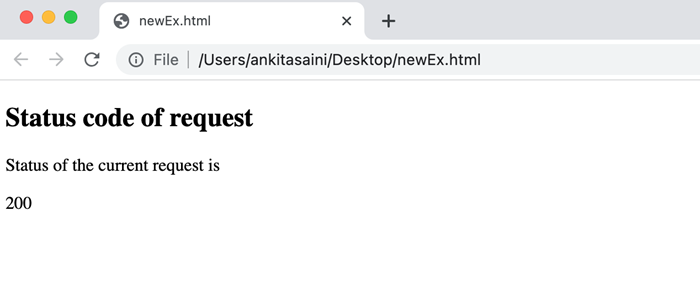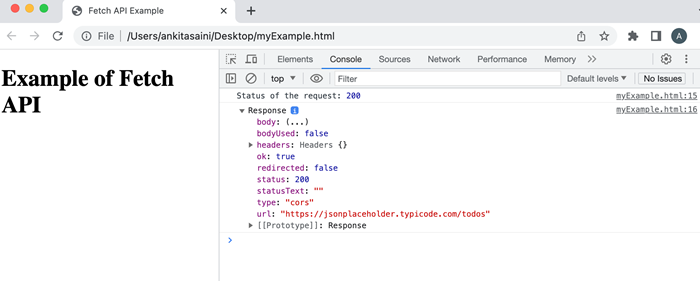
- AJAX Tutorial
- AJAX - Home
- AJAX - What is AJAX?
- AJAX - History
- AJAX - Dynamic Versus Static Sites
- AJAX - Technologies
- AJAX - Action
- AJAX - XMLHttpRequest
- AJAX - Sending Request
- AJAX - Types of requests
- AJAX - Handling Responses
- AJAX - Handling Binary Data
- AJAX - Submitting Forms
- AJAX - File Uploading
- AJAX - FormData Object
- AJAX - Send POST Requests
- AJAX - Send PUT Requests
- AJAX - Send JSON Data
- AJAX - Send Data Objects
- AJAX - Monitoring Progress
- AJAX - Status Codes
- AJAX - Applications
- AJAX - Browser Compatibility
- AJAX - Examples
- AJAX - Browser Support
- AJAX - XMLHttpRequest
- AJAX - Database Operations
- AJAX - Security
- AJAX - Issues
- Fetch API Basics
- Fetch API - Basics
- Fetch API Vs XMLHttpRequest
- Fetch API - Browser Compatibility
- Fetch API - Headers
- Fetch API - Request
- Fetch API - Response
- Fetch API - Body Data
- Fetch API - Credentials
- Fetch API - Send GET Requests
- Fetch API - Send POST Requests
- Fetch API - Send PUT Requests
- Fetch API - Send JSON Data
- Fetch API - Send Data Objects
- Fetch API - Custom Request Object
- Fetch API - Uploading Files
- Fetch API - Handling Binary Data
- Fetch API - Status Codes
- Stream API Basics
- Stream API - Basics
- Stream API - Readable Streams
- Stream API - Writeable Streams
- Stream API - Transform Streams
- Stream API - Request Object
- Stream API - Response Body
- Stream API - Error Handling
- AJAX Useful Resources
- AJAX - Quick Guide
- AJAX - Useful Resources
- AJAX - Discussion
Fetch API - Status Codes
Fetch API provide a special property which is used to find the status of the request and the name of this property is the status property. It is a read-only property of the Response interface which return the HTTP status code of the response sent by the server of the given request. For example, 404 - resource were not found, 200 - success, 400 - bad request, etc. It is supported by all modern web browsers.
Syntax
response.status
The value returned by the status property is an unsigned short number which represents the status of the current request.
Status Codes
The status codes that HTTP status returned are as follows −
Successful
The successful status codes are those status codes which will return by the server when the request is fulfilled successfully. Some of the commonly used successful status codes with their meanings are as follows −
| Status | Message | Description |
|---|---|---|
| 200 | OK | If the request is OK. |
| 201 | Created | When the request is complete and a new resource is created. |
| 202 | Accepted | When the request is accepted by the server. |
| 204 | No Content | When there is no data in the response body. |
| 205 | Reset Content | For additional inputs, the browser clears the form used for the transaction. |
| 206 | Partial Content | When the server returns the partial data of the specified size. |
Redirection
The redirection status codes are those status codes which represent the status of a redirect response. Some of the commonly used redirection status codes with their descriptions are as follows −
| Status | Message | Description |
|---|---|---|
| 300 | Multiple Choices | It is used to represent a link list. So that user can select any one link and go to that location. It allows only five locations. |
| 301 | Moved Permanently | When the requested page is moved to the new URL. |
| 302 | Found | When the requested page is found in a different URL. |
| 304 | Not modified | URL is not modified. |
Client Error
The Client error status codes represent an error that occurs on the client side during the request. Or we can say that they inform the client that due to an error, the request was unsuccessful. Some of the commonly used client error status codes with their descriptions are as follows −
| Status | Message | Description |
|---|---|---|
| 400 | Bad Request | The server cannot fulfil the request because the request was malformed or has an invalid syntax. |
| 401 | Unauthorised | The request needs authentication and the user does not provide valid credentials. |
| 403 | Forbidden | The server understood the request but does not fulfil it. |
| 404 | Not Found | The requested page is not found. |
| 405 | Method Not Allowed | The method through which the request is made is not supported by the page. |
| 406 | Not Acceptable | The response generated by the server cannot be accepted by the client. |
| 408 | Request Timeout | Server timeout |
| 409 | Conflict | The request does not fulfil due to a conflict in the request. |
| 410 | Gone | The requested page is not available. |
| 417 | Exception Failed | The server does not match the requirement of the Expect request header field. |
Server Error
The server error status codes represent an error that occurs on the server side during the request. Or we can say that they inform the client that due to an error with the server, the request was unsuccessful. Some of the commonly used server error status codes with their descriptions are as follows −
| Status | Message | Description |
|---|---|---|
| 500 | Internal Server Error | When the server encounter error while processing the request. |
| 501 | Not Implemented | When the server does not recognise the request method or lacks the ability to fulfil the request. |
| 502 | Bad Gateway | When the server acts like a gateway and recovers an invalid response from another server(upstream). |
| 503 | Service Unavailable | When the server is not available or down. |
| 504 | Gateway Timeout | When the server acts like a gateway and does not receive a response from the other server(upstream) on time. |
| 505 | HTTP Version Not Supported | When the server does not support the version of the HTTP protocol. |
| 511 | Network Authentication Required | When the client needs to authenticate to gain access to the network. |
Example 1: Finding status code using fetch() function
In the following program, we find the status code of the current request. So for that, we fetch the data from the given URL. If the response returned by the server is OK, then display the status code. If not, then display the request failed status. If we get an error, then this code uses the catch() function to handle the error.
<!DOCTYPE html> <html> <body> <script> fetch("https://jsonplaceholder.typicode.com/todos") .then(response=>{ if (response.ok){ const mystatus = response.status; // Display output in HTML page document.getElementById("sendData").innerHTML = JSON.stringify(mystatus); }else{ console.log("Request Fail:", mystatus); } }) // Handling error .catch(err =>{ console.log("Error is:", err) }); </script> <h2>Status code of request</h2> <div> <p>Status of the current request is </p> <!-- Displaying data--> <p id = "sendData"></p> </div> </body> </html>
Output

Example 2: Finding status code using fetch() function with async/await
In the following program, we find the status code of the current request. So for that, we create an async function. In this function, we fetch the data from the given URL using the fetch() function. If the response returned by the server is OK, then display the status code in the console log. If not, then display the request failed status. If we get an error, then this code uses the catch() function to handle that error.
<!DOCTYPE html>
<html>
<head>
<title>Fetch API Example</title>
</head>
<body>
<h1>Example of Fetch API</h1>
<script>
async function getStatus() {
try {
const myResponse = await fetch("https://jsonplaceholder.typicode.com/todos");
// Finding the status of the request
console.log("Status of the request:", myResponse.status);
console.log(myResponse);
} catch (err) {
console.log("Error is:", err);
}
}
getStatus();
</script>
</body>
</html>
Output

Conclusion
So this is how we can find the status code of the current request returned by the server. Using these status codes we can perform various operations such as checking if the request is successful or not, handling the specified error, or performing the appropriate action on the response returned by the server. Now in the next article, we will see how Fetch API handles errors.